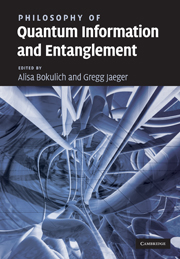Book contents
- Frontmatter
- Contents
- List of contributors
- Preface
- Introduction
- Part I Quantum entanglement and non-locality
- Part II Quantum probability
- 4 Bell's inequality from the contextual probabilistic viewpoint
- 5 Probabilistic theories: What is special about Quantum Mechanics?
- 6 What probabilities tell about quantum systems, with application to entropy and entanglement
- 7 Bayesian updating and information gain in quantum measurements
- Part III Quantum information
- Part IV Quantum communication and computing
- Index
5 - Probabilistic theories: What is special about Quantum Mechanics?
from Part II - Quantum probability
Published online by Cambridge University Press: 04 August 2010
- Frontmatter
- Contents
- List of contributors
- Preface
- Introduction
- Part I Quantum entanglement and non-locality
- Part II Quantum probability
- 4 Bell's inequality from the contextual probabilistic viewpoint
- 5 Probabilistic theories: What is special about Quantum Mechanics?
- 6 What probabilities tell about quantum systems, with application to entropy and entanglement
- 7 Bayesian updating and information gain in quantum measurements
- Part III Quantum information
- Part IV Quantum communication and computing
- Index
Summary
To my friend and mentor, Professor Attilio Rigamonti.
Unperformed experiments have no results.
Asher PeresIntroduction
More than a century after its birth, quantum mechanics (QM) remains mysterious. We still don't have general principles from which to derive its remarkable mathematical framework, as happened for the amazing Lorentz transformations, which were rederived by Einstein from the invariance of physical laws in inertial frames and from the constancy of the speed of light.
Despite the utmost relevance of the problem of deriving QM from operational principles, research efforts in this direction have been sporadic. The deepest of the early attacks on the problem were the works of Birkhoff, von Neumann, Jordan, and Wigner, attempting to derive QM from a set of axioms with as much physical significance as possible. The general idea in Ref. is to regard QM as a new kind of prepositional calculus, a proposal that spawned the research line of quantum logic, which is based on von Neumann's observation that the two-valued observables – represented in his formulation of QM by orthogonal projection operators – constitute a kind of “logic” of experimental propositions. After a hiatus of two decades of neglect, interest in quantum logic was revived by Varadarajan, and most notably by Mackey, who axiomatized QM within an operational framework, with the single exception of an admittedly ad hoc postulate, which represents the propositional calculus mathematically in the form of an orthomodular lattice. The most significant extension of Mackey's work is the general representation theorem of Piron.
Information
- Type
- Chapter
- Information
- Philosophy of Quantum Information and Entanglement , pp. 85 - 126Publisher: Cambridge University PressPrint publication year: 2010
Accessibility standard: Unknown
- 23
- Cited by
